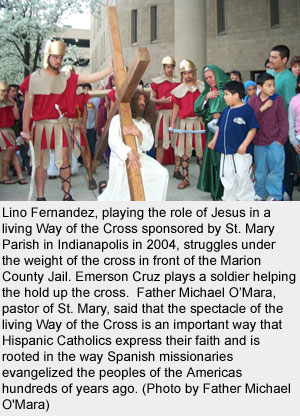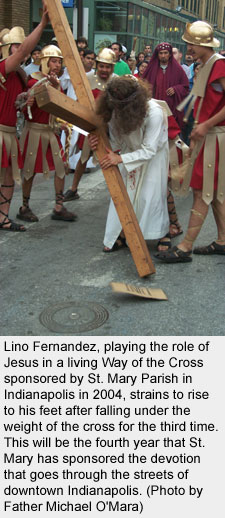Hispanics give old Lenten customs
a new home across archdiocese
By Sean Gallagher
 The suffering and death of Jesus Christ was a historical event that happened in and around Jerusalem nearly 2,000 years ago. But its power is felt in our own day to such a degree that people in many cultures act out those events as a public sign of their faith in Jesus.
The suffering and death of Jesus Christ was a historical event that happened in and around Jerusalem nearly 2,000 years ago. But its power is felt in our own day to such a degree that people in many cultures act out those events as a public sign of their faith in Jesus.
This is especially true among Catholics in Latin American countries. Many of the Hispanic Catholics who have come to live in the archdiocese will express their faith in the power of the cross through the celebration of several living Way of the Cross processions along the streets in central and sounthern Indiana.
On March 25, Good Friday, there will be three Way of the Cross processions in Indianapolis. St. Philip Neri Parish will host its processions twice at 3:30 p.m. and 7:30 p.m. St. Mary Parish will start its Way of the Cross at 4:30 p.m.
St. Mary Parish in New Albany will begin its Way of the Cross at 7:30 p.m. on Good Friday.
At 10:30 a.m. on Holy Saturday, a living Way of the Cross sponsored by St. Anthony Parish in Indianapolis will begin in Max Bahr Park across the street from the church.
Father Michael O’Mara, pastor of St. Mary Parish and administrator of St. Philip Neri Parish, both in Indianapolis, and Conventual Franciscan Father Thomas Smith of Mount Saint Francis, who assists in Hispanic ministry in the New Albany Deanery, spoke about the meaning of the living Way of the Cross for Catholics in and from Latin America.
Father O’Mara said that the practice is rooted in the way that the Spanish evangelized the natives of Central and South America centuries ago, exploring that they often did it “through pageantry.”
That purpose of evangelization still exists, he said.
 “It’s a great tool for evangelization… ”, Father O’Mara said, “because we don’t limit participation to only those who are at Mass on Sunday with us every week. It attracts people who may not be active, but because of this important expression of their piety, their religiosity, they want to be involved in this Via Crucis.”
“It’s a great tool for evangelization… ”, Father O’Mara said, “because we don’t limit participation to only those who are at Mass on Sunday with us every week. It attracts people who may not be active, but because of this important expression of their piety, their religiosity, they want to be involved in this Via Crucis.”
But the evangelization that can happen through celebrating Jesus’ Passion and death can also touch passers-by on the city streets where it happens.
“I think that it causes people to stop and reflect,” Father O’Mara said. “We start this at 4:30, so we get downtown at about 5:15, right when people are getting off work and going home. And people stop.
“People who are walking stop. People who are driving by are watching. It has to have an impact on them. It has to remind them of what the day is. And so, it’s a very, very interesting dynamic to watch that happen, ” Father O’Mara said.
This tradition among the Hispanics is starting to gain roots in the archdiocese. The celebration at St. Mary Parish in New Albany will mark the seventh year that it has happened, while St. Mary Parish in Indianapolis is hosting its living Way of the Cross for the fourth time.
It also has started to attract a large number of people to witness them and pray along as they are celebrated. Father Thomas said that approximately 300 people came to last year’s Way of the Cross in New Albany. More than 400 people walked the downtown streets of Indian-apolis last year for the one hosted by St. Mary Parish, according to Father O’Mara.
Father Thomas encouraged those who do not understand Spanish to come and follow along in bilingual booklets that will be provided. Father O’Mara noted that, while St. Mary and St. Philip Neri parishes’ Way of the Cross processions will be celebrated in Spanish and booklets will not be provided, it can still be powerful for those who may not be able to understand what is spoken.
“I don’t think that anybody will be inhibited from understanding because we already know the words,” he said. “It’s just trying to put ourselves into how that looked with Jesus and how it might have been.”
In reflecting on the overall meaning of the event, Father Thomas spoke about the great potential that it can have for all involved.
“I think it gives us a more realistic and more personal awareness of the life of Christ and his gift to us on Good Friday,” he said. “It’s meant to deepen our faith and to help us, in a sense, act out and live out our own faith as well as the faith of Jesus. For me, it’s a really beautiful moment.” †
 The suffering and death of Jesus Christ was a historical event that happened in and around Jerusalem nearly 2,000 years ago. But its power is felt in our own day to such a degree that people in many cultures act out those events as a public sign of their faith in Jesus.
The suffering and death of Jesus Christ was a historical event that happened in and around Jerusalem nearly 2,000 years ago. But its power is felt in our own day to such a degree that people in many cultures act out those events as a public sign of their faith in Jesus.  “It’s a great tool for evangelization… ”, Father O’Mara said, “because we don’t limit participation to only those who are at Mass on Sunday with us every week. It attracts people who may not be active, but because of this important expression of their piety, their religiosity, they want to be involved in this Via Crucis.”
“It’s a great tool for evangelization… ”, Father O’Mara said, “because we don’t limit participation to only those who are at Mass on Sunday with us every week. It attracts people who may not be active, but because of this important expression of their piety, their religiosity, they want to be involved in this Via Crucis.”